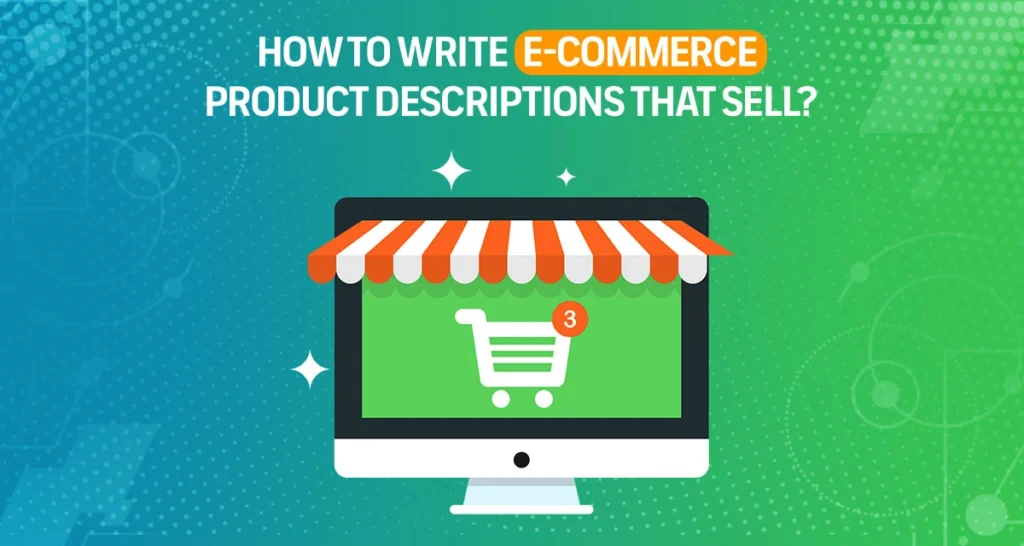When it comes to selling products, the key is to paint a picture in your customers’ heads of what life could be like with your products. However, for e-commerce businesses creating this mental picture is a heavy challenge. How can you conjure this vision when your customer cannot even touch or see the actual product in person? This is where the power of a compelling e-commerce product description comes into play.
A Global Retail Study by Google in 2019 revealed that 85% of shoppers say product information, along with product images, are crucial when deciding which brand or retailer to choose.
In today’s competitive landscape of e-commerce, product description is no longer just about listing your features or using flowery language. But what really makes a good product description for an e-commerce store?
Continue reading, as we’re about to uncover the secrets of writing product descriptions that captivate, convert, and ultimately, seal the deal. We’ll also include some examples to show you how it’s done!
Why is a Good Product Description Important for E-commerce?

Regardless of your industry and your marketplace, quality product descriptions play a significant role in e-commerce success. They directly impact online sales and even brand brand loyalty.
According to Salsify research, 88% of shoppers say a detailed product description plays a very important role in their purchase decisions.
Meanwhile, the Product Information Report produced by Shotfarm found that poor product descriptions are among the top reasons (30%) for abandoned online shopping carts. And it doesn’t stop there, 40% of consumers have actually returned online purchases because of poor product content.
Trust is paramount, and retailers offering inaccurate information risk a major blow. The same study also revealed that 87% of shoppers would unlikely make a repeat purchase when they encounter wrong information.
McKinsey & Company’s report highlighted the importance of accuracy in product data. They found that errors in product descriptions can lead to a loss of up to 23% in clicks and 14% in conversions.
The message is clear here: lousy product descriptions are a recipe for disaster in e-commerce. Poor product data translates to lost sales, eroded brand loyalty, and a tarnished reputation.
8 Tips for Writing Effective Product Descriptions for Your Online Store

By now, the power of quality product descriptions is undeniable. But, how do you write product descriptions that convert? Here are some tips and best practices to improve your e-commerce product description.
1. Create a Connection
A great product description creates a connection with the customer. That’s why you need to write a product description that speaks directly and personally to your target audience.
However, before you can create such connections, it’s crucial to understand your audience deeply. Having a buyer persona may help you at this point. Identify your customers’ desires, challenges, and aspirations.
2. Benefits Over Features
Yes, features are important, but benefits sell.
We’re not suggesting you ditch them entirely – technical details can be crucial for certain products, like skincare ingredients or power tool specifications.
However, instead of just listing features as bullet points, highlight the benefits they deliver. Write product descriptions that showcase how each feature solves a specific customer problem.
For example, let’s say you’re selling a wireless headphone with these features:
- Wireless Bluetooth headphone
- Built-in microphone
You can write a benefit-focused description that speaks directly to the customer’s needs:
- Our wireless headphones eliminate the hassle of tangled cords, letting you move freely while you listen.
- Never miss a beat. The built-in microphone lets you take calls without reaching for your phone, perfect for staying connected on the go.
The product description sample above showcases how the features solve a problem. Remember, people buy solutions, not features.
3. Optimize for Search Engines
Many new e-commerce businesses mistakenly believe they don’t need SEO. They believe their website would automatically rank high on the search engine result page simply because they are a store, not a blog. This couldn’t be further from the truth.
In fact, Bright Edge research revealed that SEO drives over 1,000% more traffic than organic social media!.
Meanwhile, according to the study by Digital Commerce 360, most visitors to the Top 1000 e-commerce stores arrive through organic search.
Keep in mind, however, that search engine algorithms evolve constantly. To stay ahead, we recommend aligning your e-commerce website with Google’s EEAT concept. While not a direct ranking factor, it offers a roadmap for creating valuable content that Google’s algorithm prioritizes.
This is especially important for e-commerce sites that fall under the YMYL (Your Money, Your Life) category, where Google applies stricter scrutiny.
4. Use Sensory Words
A great product description engages the customer’s senses. It transports the customer into an experience, allowing them to imagine themselves using and enjoying your product.
To do this, you need to use a sensory language to describe your product. Sensory language taps into the five senses – sight, touch, smell, taste, and sound – to create a vivid picture in the reader’s mind.
For example, let’s say you are selling scented candles. Instead of saying that your product has a flagrant scent, consider this:
Imagine: The warm glow flickering on your bookshelf as you light our candle. A wave of invigorating citrus fills the air, instantly transporting you to a sun-drenched orchard. Sweet notes of mandarin and tangy grapefruit dance with a hint of peppery basil, creating an atmosphere of pure refreshment.
See the difference? This description evokes a multi-sensory experience. By using sensory language, you move beyond just features. Here, your product description creates a compelling story that captures the customer’s imagination and makes them yearn to experience your product
5. Create Scarcity and Urgency
This tactic in writing product descriptions plays on the fear of missing out. People don’t want to be left behind if a product is popular or in short supply. The result: they would purchase decisions without thinking too much.
There are many ways to incorporate this in your product description. And it doesn’t need to be a whole paragraph. You can use countdown timers or highlight discounts or promotions that are only valid for a specific period.
In fact, you can simply mention the number of units left in stock. Phrases like “only 5 left!” or “selling fast” can create a sense of scarcity.
Take what Lotus Tools Philippines did on their product page:

This is a good example of a product description that uses a scarcity tactic. Their product page shows both the remaining stock level and the number of concurrent viewers.
Imagine a customer actively researching nailers and they see only one left in stock! This creates a sense of urgency, prompting them to act fast before the opportunity disappears.
Keep in mind, however, that this tactic should be used strategically and ethically. Don’t constantly display low stock unless it’s true. This can erode trust with customers who may feel manipulated.
6. Answer FAQs
Intricate products like tech gadgets, furniture, appliances, or even cosmetics can leave customers with unanswered questions and hesitation. A well-crafted FAQ section is a perfect way for you to discuss this complexity.
By having an FAQ section, you can address potential concerns that might stop someone from buying. Providing clear answers can increase customer confidence in the product and their decision to purchase it.
You can also use your FAQs to target relevant keywords naturally. This can help you boost your product search ranking and attract more qualified leads.
In creating an FAQ for your product description, you need to step into your customers’ shoes and identify areas where knowledge gaps might exist. You can also look at reviews, social media comments, or past inquiries in creating a question.
7. Include or Encourage Reviews
Your customers read reviews. According to the latest finding of Baynard Institute, 95% of users relied on reviews to understand products better. That said, your very own customers can become your advocates.
Asking your customer to leave a review about your products. The more they discuss your product feature the more advantage you can get. You can also use these reviews to understand what matters to your customer.
However, building a robust review base takes time. If you don’t have enough customers yet, you can collaborate with relevant influencers. Sending them your product for review can generate valuable content that showcases its features in action.
Of course, this may require you to set a budget. However, the payoff can be significant. You can showcase your collaboration not only on your product page but also on your social channels.
Images of real people using your product create a perception of popularity and trust. It’s a form of social proof that can significantly influence your customers’ buying decisions.
8. Keep it Simple and Scannable
At this point, you’re probably thinking of including several sections in your product page. That’s okay, but make sure to make it scannable and simple.
Remember that in today’s digital world, attention spans are short. So, make sure that your customers can grasp your product’s benefits, locate FAQs, and browse customer reviews quickly.
Make your product description easy to read. You can use bullet points, short paragraphs, and clear headings to break up your text.
Write Product Descriptions that Convert
The competition in the e-commerce world is becoming fiercer each day. Bland product descriptions simply won’t cut it anymore. So, make yours stand out.
Are you unsure if your product pages are converting? Be Global E-commerce Corporation is here to help. We write captivating product descriptions that highlight benefits, ignite interest, and turn clicks into sales.
Contact us today and let us craft a killer product description.





